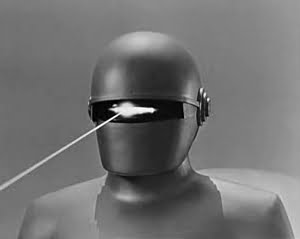Someone Is Getting It Right
So if you missed the relaunch of the Cosmos series last night with Neil deGrasse Tyson, I would recommend tuning in on Friday to watch. There is plenty to say about his personal views and maybe even some of the slant that the series will take, but it does a good job of emphasizing that science relies on theories that are evaluated against evidence. And when the evidence proves the theory wrong, we throw out the theory and try again. If you have kids in the house, the first episode did a great job of placing us in the universe (or even multi-verse) in both space and time. So National Geographic and Fox are doing a bang up job getting this on the air.
Second, GorT just got wind of a BBC America four-part documentary that will premier on April 19th titled, The Real History of Science Fiction. With a lineup that includes William Shatner, Nathan Fillion, Zoe Saldana, Steven Moffat, Ronald D. Moore, Christopher Lloyd, Rutger Hauer, Neil Gaiman, Ursula K. Le Guin, Kenny Baker, Donald Bellisario, Nichelle Nichols, Peter Weller* and Edward James Olmos, it should be impressive. It will be narrated by Mark Gatiss who plays Sherlock Holmes’ brother, Mycroft, on the BBC series Sherlock and has appeared in numerous science fiction series including Doctor Who and Hitcher’s Guide to the Galaxy. The first episode is titled Robots and will likely feature a guest appearance by yours truly. I mean, if you were talking about Science Fiction and robots, how could you not include GorT??
What if our creations turn against us? The idea of creating life has fascinated society since the earliest days of science fiction. The first installment of the four-part series, Robots transports viewers from the first steps of Frankenstein’s monster to the threat provided by the Terminator and the world of Cyberspace. Find out how Rutger Hauer created one of the greatest speeches in all of science fiction for Blade Runner. Discover from Kenny Baker the challenge of acting in Star Wars while inside the body of R2D2, and learn how Anthony Daniels was drawn to the role of C-3PO by concept art modeled closely on the robot from the silent classic Metropolis. Douglas Trumbull (2001: A Space Odyssey, Blade Runner) discusses how he managed to create a whole new approach to robot design. The creators of the original Robocop describe how its hidden depths have given it enduring appeal and William Gibson reveals the origins of his seminal novel Neuromancer. From HAL in 2001: A Space Odyssey to the Cylons of the reimagined Battlestar Galactica and the world of The Matrix, this is a journey that asks – what does it mean to be human?
Episode 2 is about Space, 3 covers Invasions and it wraps up with an episode on Time.
I look forward to the series.
* It is worth noting that they credit Peter Weller for Robocop but not his better work, The Adventures of Buckaroo Banzai Across the 8th Dimension. And if you think I’m joking, ask the Volgi. Do it.

GorT is an eight-foot-tall robot from the 51ˢᵗ Century who routinely time-travels to steal expensive technology from the future and return it to the past for retroinvention. The profits from this pay all the Gormogons’ bills, including subsidizing this website. Some of the products he has introduced from the future include oven mitts, the Guinness widget, Oxy-Clean, and Dr. Pepper. Due to his immense cybernetic brain, GorT is able to produce a post in 0.023 seconds and research it in even less time. Only ’Puter spends less time on research. GorT speaks entirely in zeros and ones, but occasionally throws in a ڭ to annoy the Volgi. He is a massive proponent of science, technology, and energy development, and enjoys nothing more than taking the Czar’s more interesting scientific theories, going into the past, publishing them as his own, and then returning to take credit for them. He is the only Gormogon who is capable of doing math. Possessed of incredible strength, he understands the awesome responsibility that follows and only uses it to hurt people.


